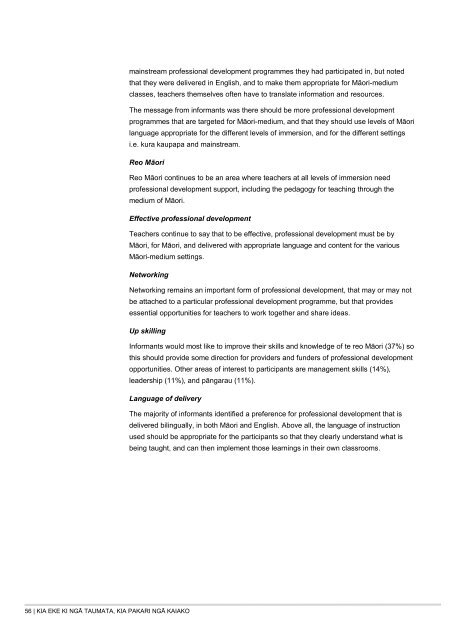mainstream professional development programmes they had participated in, but notedthat they were delivered in English, and to make them appropriate for Māori-mediumclasses, teachers themselves often have to translate information and resources.The message from informants was there should be more professional developmentprogrammes that are targeted for Māori-medium, and that they should use levels of Māorilanguage appropriate for the different levels of immersion, and for the different settingsi.e. kura kaupapa and mainstream.Reo MāoriReo Māori continues to be an area where teachers at all levels of immersion needprofessional development support, including the pedagogy for teaching through themedium of Māori.Effective professional development<strong>Te</strong>achers continue to say that to be effective, professional development must be byMāori, for Māori, and delivered with appropriate language and content for the variousMāori-medium settings.Networ<strong>ki</strong>ngNetwor<strong>ki</strong>ng remains an important form of professional development, that may or may notbe attached to a particular professional development programme, but that providesessential opportunities for teachers to work together and share ideas.Up s<strong>ki</strong>llingInformants would most like to improve their s<strong>ki</strong>lls and knowledge of te reo Māori (37%) sothis should provide some direction for providers and funders of professional developmentopportunities. Other areas of interest to participants are management s<strong>ki</strong>lls (14%),leadership (11%), and pāngarau (11%).Language of deliveryThe majority of informants identified a preference for professional development that isdelivered bilingually, in both Māori and English. Above all, the language of instructionused should be appropriate for the participants so that they clearly understand what isbeing taught, and can then implement those learnings in their own classrooms.56 | KIA EKE KI NGĀ TAUMATA, KIA PAKARI NGĀ KAIAKO
BIBLIOGRAPHYAitken, H., Bruce Ferguson, P., McGrath, F., Piggot-Irvine, E., Ritchie, J., (2008) Learningto <strong>Te</strong>ach: Success Case Studies of <strong>Te</strong>acher Induction in Aotearoa New Zealand.Wellington: New Zealand <strong>Te</strong>achers Councilhttp://www.teacherscouncil.govt.nz/communication/publications/research0013.stm.Bartell, C.A., (2004) Cultivating High-quality <strong>Te</strong>aching Through Induction and Mentoring,Corwin Presshttp://books.google.co.nz/books?id=KXUzU8wiwlQC&pg=PA24&lpg=PA24&dq=Stages+of+a+teaching+career&source=web&ots=qtSnjbxyel&sig=k2atqO9t6bqlA51_htbvt9zFhoc&hl=en&sa=X&oi=book_result&resnum=4&ct=result#PPR5,M1.Bishop, R., Berryman, M., Powell, A. & <strong>Te</strong>ddy, T. (2007). <strong>Te</strong> Kotahitanga Phase 2 -Towards a whole school approach. Wellington: Ministry of Education. Cited athttp://www.educationcounts.govt.nz/publications/series/9977/9904.Cameron, M. (2007) Learning to <strong>Te</strong>ach: A Literature Review of Induction Theory andPractice. Wellington: New Zealand <strong>Te</strong>achers Councilhttp://www.teacherscouncil.govt.nz/communication/publications/research0009.stm.Cameron, M., R. Dingle, Broo<strong>ki</strong>ng, K., (2007) Learning to <strong>Te</strong>ach: A Survey ofProvisionally Registered <strong>Te</strong>achers in Aotearoa New Zealand. Wellington: NewZealand <strong>Te</strong>achers Councilhttp://www.teacherscouncil.govt.nz/communication/publications/research0010.stm#h73.Cameron, M., Garvey Berger, J., Lovett, S., Baker, R., (2007) Early career teachers'opportunities for professional learning: Impacts on teaching practice, job satisfaction,motivation, and career decisions, New Zealand Council for Educational Research,Wellington, New Zealand, University of Canterbury College of Education, Christchurch,New Zealand. Paper presented at BERA 2007 annual conference, Institute of Education,London, 7 September 2007. http://www.nzcer.org.nz/default.php?products_id=1924.Dewar, S., Kennedy, S., Staig, C., Cox, L. (2003) Recruitment and Retention in NewZealand Secondary Schoolshttp://www.educationcounts.govt.nz/publications/schooling/5307.Education Review Office, Managing Professional Learning and Development inSecondary Schools, May 2009, Wellingtonhttp://ero.govt.nz/publications/pubs2009/pld-sec-may09.pdf.Fryer, K., Kalafatelis, E. & Murrow, K. (2007). Second Language Acquisition for English-Medium Secondary <strong>Te</strong> Reo Māori <strong>Te</strong>achers - Evaluation of the PD Pilot Programme.Wellington: Ministry of Education. Cited athttp://www.educationcounts.govt.nz/publications/maori_education/16837.57
- Page 1 and 2:
Kia eke ki ngā Taumata, kia Pakari
- Page 3 and 4:
CONTENTS4 Executive Summary7 Recomm
- Page 5 and 6: that further promotion may be neede
- Page 7 and 8: RECOMMENDATIONSBased on the finding
- Page 9 and 10: 2. BACKGROUNDIn 1999, there were ap
- Page 11 and 12: 3. RESEARCH METHODOLOGYKaupapa Māo
- Page 13 and 14: The following table shows the numbe
- Page 15 and 16: The majority (63%) of teachers part
- Page 17 and 18: Teacher RegistrationOf the total 45
- Page 19 and 20: of other professional programmes, i
- Page 21 and 22: 25%), paperwork (7% vs. 14%), stres
- Page 23 and 24: competent, confident, skilled, enth
- Page 25 and 26: valuing professional learning, they
- Page 27 and 28: Ako Panuku is the new programme dev
- Page 29 and 30: Resource Teachers: Literacy (Māori
- Page 31 and 32: websites such as Te Kete Ipurangi (
- Page 33 and 34: worthwhile securing and leveraging
- Page 35 and 36: Resource teachers of Māori are by
- Page 37 and 38: Q9 Of the following incentives and
- Page 41 and 42: number of Resource Teachers of Māo
- Page 43 and 44: translating activities and tools fr
- Page 45 and 46: The table below shows the responses
- Page 47 and 48: Child care and family commitments 2
- Page 49 and 50: Impact of professional development
- Page 51 and 52: Informants were also asked about th
- Page 53 and 54: TimingProvided in Māori - atapprop
- Page 55: Q15 Is there any type of support or
- Page 59 and 60: http://books.google.co.nz/books?id=
- Page 61 and 62: APPENDIX 1: INFORMATION SHEETPartic
- Page 63 and 64: APPENDIX 2: CONSENT FORMParticipant
- Page 65 and 66: • aroha ki te tangata (a respect
- Page 67 and 68: initially be contacted by phone to
- Page 69 and 70: in-service professional development
- Page 71 and 72: APPENDIX 4The information presented
- Page 73 and 74: Option 2 (Auckland): St Dominic’s
- Page 75 and 76: InterLEAD Consultants, Term One Pro
- Page 77 and 78: Waikato University - WorkshopUsing
- Page 79 and 80: http://www.educationanswers.com/sem
- Page 81 and 82: Time: 9am-3.30pmCost: $980 +GST (in
- Page 83 and 84: For registrations please email avai
- Page 85 and 86: http://www.waec.ac.nz/shared/plp/ta
- Page 87 and 88: Audience: educators and curriculum
- Page 89 and 90: Venue:Southland Campus, 100 Nelson
- Page 91 and 92: Delivery and content, plus hands-on
- Page 93 and 94: Date: Tuesday 31 MarchTiime: 8:30am
- Page 95 and 96: ctionid=28Manukau Institute of Tech
- Page 97 and 98: Effective Communications - Communic
- Page 99 and 100: Ministry of Education: Educational
- Page 101 and 102: http://www.edgazette.govt.nz/Notice
- Page 103 and 104: secondary school sector, and can be
- Page 105 and 106: Contribution to wider school activi
















